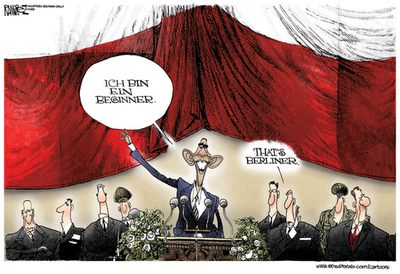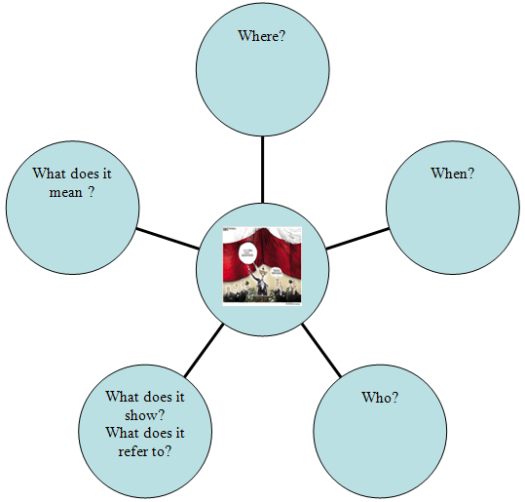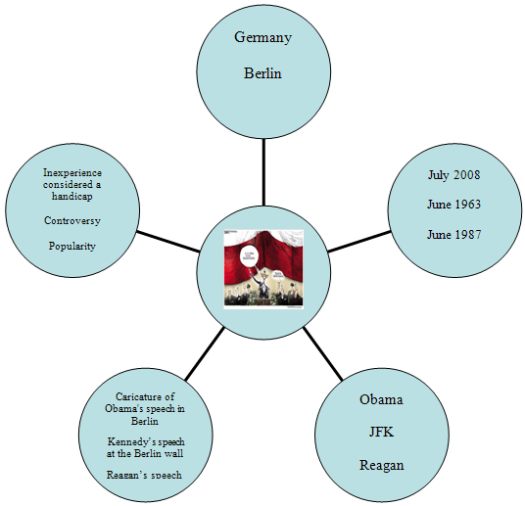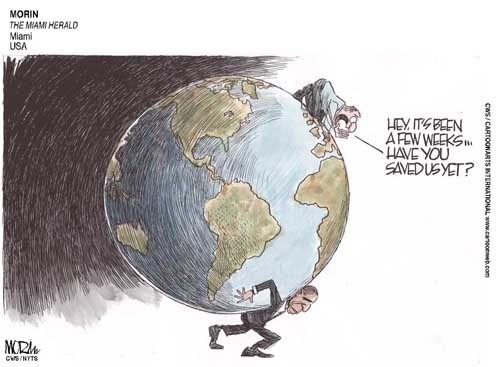Using Political and Economic Cartoons in the ESP Classroom
Jean Jimenez, Italy
Jean Jimenez teaches EAP and ESP at the Faculty of Economics, Università della Calabria (Italy). She holds an MA in TEFL from the University of Reading, UK. Her current research interests include ICT based teaching and learning, corrective feedback, and ESP.
E-mail: jeanjimenez@libero.it
Menu
Introduction
Why use cartoons in the ESP classroom
How to use one-frame cartoons in the classroom
Conclusion
Acknowledgements
References
As EFL teachers we often find ourselves trying to come up with creative and innovative material which students will find useful, motivating and interesting. When dealing with small classes, there is a wide range of activities we can carry out; having larger groups, however, makes things a bit more complicated. In particular, at the Faculty of Economics (Università della Calabria, Italy) I teach some courses which are made up of as many as 100 students, who have, on average, an A2/B1 level. The courses provide skill and task-based content in the field of business, economics and social sciences through the use of authentic material which includes articles, extracts from textbooks, graphs and videos, and focus mainly on study skills such as finding and understanding the main idea of a text, identifying key words and discourse markers, summarizing main points and giving an oral report on an article. It is therefore important to involve students in activities which aim at satisfying their academic needs, are intellectually stimulating and, hopefully, also arouse the students’ interests.
This article looks at the use of one-frame political and economic cartoons in the ESP classroom as a different way of generating discussion on current issues as well as offering an opportunity for students to develop and reenforce their vocabulary. In particular, I will focus on the activities I have used in class, including some of the ideas developed by the students, try to explain the rationale behind the activities, and discuss their effectiveness.
“[...] the right picture at the right time may be worth several times that many words.” (Cary 2004: 23)
I have found that using one-frame cartoons can be an interesting way of providing input for discussions on current economic, political and social issues. Cartoons can be used at any level for a variety of language activities set up to meet the students’ needs. Students are not only attracted by the visual input (Bangs 1988, Cary 2004, McCloud 1993), but also by the chance to discuss events and issues in an ‘alternative’ way. Indeed, because of their multidimensional nature (Goodman and Graddol 2005), comics can help capture the attention of even the least motivated students and provide the basis for oral and written discourse which can range from a simple description of the setting to a complex and meaningful discussion on an important news event. Cartoons are able to integrate cultural, social, political and historical content thus offering a rich resource for discussion and vocabulary building. Moreover, they are a great way to add humour into any language class.
What follows is an example of how a 45-minute lesson can be developed. It starts with a whole class open guided session to demonstrate what the students will later be doing by themselves in smaller groups.
Warm-up (15 minutes)
I start the lesson by projecting a cartoon onto a screen and asking students to tell me the first words that come to their mind. This is a type of free association activity, which works as a way of allowing the more vociferous students to break the ice and sets the scene for the activities that will follow. At this point any words/comments are accepted and written down.
Here is an example of a cartoon I used with one of my classes a year after Barack Obama took office:

The first words that the students came up with were Obama, German, speech, politics, Berliner and president. Having elicited some general observations, we could now begin to focus in detail on the themes presented. I asked the students to try to analyze and interpret the cartoon, encouraging them to concentrate not only on the present, but also on important historical events. In order to guide them, I posed the following questions in the form of this mind map:

This brainstorming activity led to a great deal of interaction as students saw it as a sort of competition and tried to give the right answers, and what one student said led others to think of related answers. Moreover, they were very curious and kept asking me for hints, which I gave mostly in the form of other questions. I wrote their answers on the screen and this was what we came up with:

As can be seen, there is reference to the present, but also to two other important events: Kennedy’s speech at the Berlin Wall in 1963, strictly related to the cartoon, and Reagan’s speech in 1987, which, although not directly referred to in the cartoon, is nevertheless linked to Obama’s speech. After some urging on my part, the students were able to remember not only Kennedy’s famous phrase "Ich bin ein Berliner", but also Reagan’s "Mr. Gorbachev, tear down this wall!". There was a short discussion on the similarities between Kennedy and Obama, and then a longer one on Obama’s qualifications and on his image. This set the scene for the second part of the activity.
Group work (15 minutes)
Now that the students had had the chance to analyze and discuss a cartoon together as a class and were therefore familiar with how to approach a cartoon, the next step was to ask them to work in groups of 4/6 and comment on another cartoon depicting Obama. I asked them to write down words/phrases/sentences around the image; they could use the questions given above to help guide them or any other approach they wanted. Here are the ideas they developed for the following cartoon:

Students’ output
- Mr. Obama is considered as the president of the world. The global population pretends from Obama the best in a few time. Mr. Obama is promoting a lot of reforms in order to make life better to everyone. He is trying to be strong, in the Copenhagen conference, to save the world from global warming.
- When Obama became president more responsibility of the problem of the USA and the world are on his shoulders, but he cannot resolve all problems because he is only one.
- Who? Obama and a common man.
When? A few weeks after Obama’s election.
What does it show? What does it refer to? Obama is carrying the world. The world has hope in Obama to save the global economy.
What does it mean? It is not realistic to believe that one man can save the world and in so few time.
- Obama World People Hope Responsibility Heavy
Dangerous Water Life Poverty Wealth Heart
- America → economic point of view
Peace → social point of view
Financial crisis → 1929, which was one of the causes of WWII
USA vs. IRAQ → political point of view
- Who? Obama and a common man.
When? A few weeks after Obama’s election.
What does it show? What does it refer to? Hope- Dream- Trust- Challenge- responsibility
What does it mean? Possibility: Disappointment or Legacy- Time is important
- Common man: we trust in you!
Obama: No, I haven’t! It’s very difficult because the world is heavy! But I’m a strong man and I hope I can do it.
- economic situation
- peace in the world
- pollution
- development of the countries
-
- Political cartoon
- Obama and the common man
- Social problems
- Weight of the world
- Lack of trust for the president
- Obama
Poverty
World- globalization, climate pollution→ important nations in the world
Financial crisis→ fall of Wall Street, 1929, suicide
Racism→ social division, first African American president
War→ Retirement of US troops
Nobel Prize for peace
- Obama World Responsibility President Democratic
Reforms Hope Freedom Change War
- Hope Dream
World Trust
President Responsibility Help
America Europa
Hard work Objectives
- Obama American elections In charge of the world
World Many problems Much responsibility
Different cultures Peace in the world
Discussion Committees Nobel peace prize
Diplomatic man
- Economic situation
Social situation
USA’s power
Hope in Obama
More responsibility on Obama
The difficulty to be the president of the USA now
The world needs new ideas
- Responsibility
Economic crisis
Peace in the world
The food in the world
Racism
The different distribution of wealth
The problem of water
Religious wars
The problem of Guantanamo
Pollution
Presentation (15 minutes)
Once the groups had finished writing down their ideas, I collected the sheets of paper and picked 5 at random. One member of each of the groups chosen was asked to come to the front of the room and present their interpretation of the cartoon, explaining why they had chosen certain words. This offered the opportunity for students to practice their oral and aural skills and allowed for a great deal of student- centered discussion, with the teacher acting as a facilitator.
This type of activity is simple to organize and allows for very topical themes to be brought into the classroom almost as soon as they happen. It provides a good way of giving students the opportunity to discuss important issues in English that they are already familiar with in their L1, and helps reinforce and develop vocabulary. The use of a cartoon gives a strong visual input which means that students of various levels can participate as they are not impeded by the language used.
The activity develops in such a way as to guide the whole class into interaction by building up the level of participation. It enhances students’ critical thinking skills and allows a great variety of possible answers as students are encouraged to interpret the cartoon in their own way and so are not penalized or made to feel that their contribution is not relevant. The final presentations concern a topic that all the class has worked on, discussed, and is hopefully, by this time, interested in. Although only one person is presenting, all of the members of that group know that they have provided input. Moreover, students from other groups are also curious to compare their ideas with those of their peers. At the end of the activity the students should understand the significance of the cartoon and see that they are capable of discussing complex political, social and economic issues in English.
I would like to thank the students from the degree course in Economics who participated in this activity and allowed me to use their ideas.
Bangs, C. (1988). The use of cartoons in the learning of a second language. Journal of the Australian Modern Language Teachers' Association, 23(3), 10-14.
Cary, S. (2004). Going Graphic: Comics at Work in the Multilingual Classroom. Portsmouth, NH: Heinemann.
Goodman, S. And Graddol, D. (2005). Redesigning English: new texts, new identities. London:
McCloud, S. (1993). Understanding Comics-The Invisible Art. New York, NY: Kitchen Sink Press for Harper Collins.

The British Life, Language and Culture course can be viewed here


|